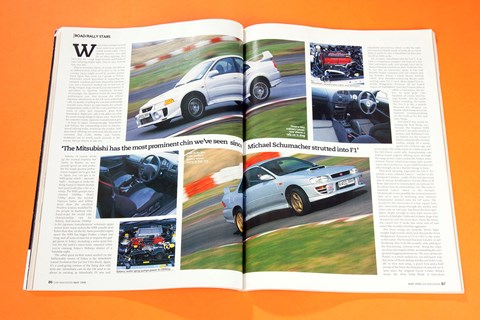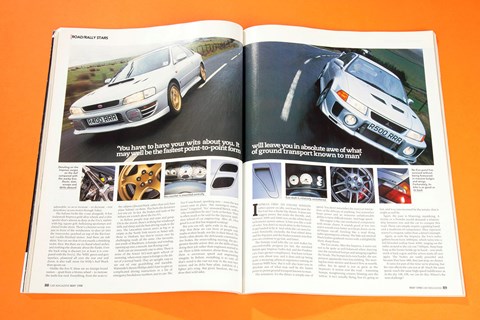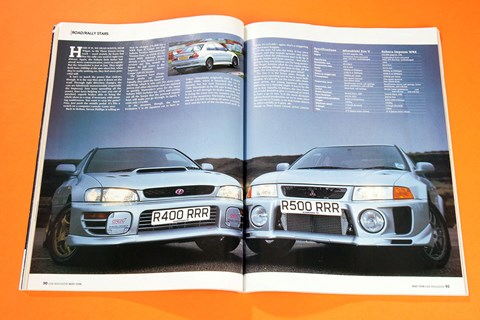► Subaru Impreza WRX vs Mitsubishi Evo V
► Revisit our original twin test from May 1998
► ‘It isn’t actually flying, but it’s so fast it might as well be’
Raw Like Sushi – The Mitsubishi Evo V and Subaru Impreza WRX are two of the tastiest, most breathtakingly capable homologation cars we have ever driven. They are also two of Japan’s best-kept secrets.
Wild Lancashire moorland, miles from anywhere, a dark stormy night. This is spooky country, just right for an alien sighting. And here they are: wings, huge mouths and banks of eyes radiating bright light. They’re also moving very, very fast.
They’re terrestrial aliens, of course, but they’re so different from what we’ve seen so far in this country, Japan might as well be another planet. From Japan they come via a garage in Bolton. Warrender, which specialises in importing the weirdest, wackiest and least obtainable Japanese cars, has a forecourt stacked out in this sort of things, winged, large-snouted and ostentatious. It specialises in Japanese machinery because, increasingly, the Japanese build the best high-performance cars. And because the official Japanese distributors in the UK seem pathologically incapable of selling the cars that enthusiasts actually want, there’s an opportunity for a small, independent outfit to fill the void (and there are loads of other ‘grey importers’ apart from Warrender).
Right now, rally look-alikes are what the smart young things in Japan want. And what the customer wants, Japanese manufactures give – at least in Japan. Unsurprisingly, Mitsubishi and Subaru, the outstanding teams in international rallying today, dominate the market. And their latest offerings not only look like the sort of monsters that Colin McRae and Tommi Makkinen use to terrify small animals in the forests, they go almost as fast, too.
Subaru, of course, serves up the normal Impreza 4×4 Turbo in Britain, an awesomely good car and probably the single greatest performance bargain we’ve got. But in Japan you can get it in WRX guise, which – astonishingly – manages to make the thing found in British dealers feel (and look) like a bit of a wimp. The WRX pumps out a claimed 280bhp. That’s 72bhp above the normal Impreza Turbo, and 40bhp more than the excellent Prodrive versions, modified by the people in Banbury who hand-make the world rally Chapmionship cars for Subaru. And anyway, 280bhp is the Japanese manufacturers’ voluntary upper power limit: many reckon the WRX actually does better than that, on the sly. More powerful engine apart, the WRX has bigger brakes, a larger rear wing, and all sorts of extra kit to impress the gadget gurus in Tokyo, including a water spray button for the turbo’s intercooler, essential when you’re cruising Tokyo’s Shibuya district of a Saturday night.
The other great mobile status symbol on the fashionable streets of Tokyo is the Mitsubishi Lance Evolution Five (or Evo V for short). Again, it’s a road-going version of the thing that rally stars use. Mitsubishi cars in the UK tend to be about as exciting as Mitsubishi TV sets and Mitsubishi microwaves, which is why the fashion-conscious British youth of today are no more likely to aspire to own a Mitsubishi car than they would an M&S cardie.

Yet, in Japan, Mitsubishi sells the Evo V, a car with a competition pedigree, the look of a Star Wars interceptor craft, and enough fancy kit to distract Japanese youth from their Nintendo 64s. It, too, has an intercooler spray. It has vast Brembo brakes complete with red calipers and big ‘Brembo’ letters, a lovely Momo steering wheel, deep shoulder-embracing Recaro seats and big, open OZ 17-inch alloys ringed by low-profile Bridgestone Potenzas. All the brand names are highlighted. Even the Pioneer radio is called a Carrozzeria, the letters in bold gold. The Japanese, of course, love foreign brands, and the more Italian sounding, the better. The Evo V is like a mobile showcase for designer car brands, ideal transport for the Japanese twenty-something on the lookout for the next New Thing.
And they’ll very nearly be buying the Real Thing, too, because the Impreza WRX and Evo V are quite similar to McRae’s and Makkinen’s forest wheels. For the Group N British national rally championship, simply fit a sump-guard and a rollover cage, and you’re away. The works teams do a little more for the full-blown world rally championship cars (laptop-tuned engines offering more through-the-range power, water-cooled disc brakes, transmission ‘brains’ which bias torque split according to driver preference, seam-welded bodies for extra strength, etc etc). But the lineage is there.
They look amazing, especially the Evo V. It’s plainly a very ordinary Lancer – similar to the European Carisma – under all the war paint and suit-of-armour aerodynamics, but the effect of all these add-ons is to transmogrify an ordinary little saloon into an extraordinary one. The nose is standard Lancer, down to the bumper. Underneath is very possibly the most prominent chin we’ve seen in motoring since Michael Schumacher strutted onto the GP scene. The mouth for the intercooler is a vast, square hole (the intercooler peeps through the mesh), and either side sit vast eyes, big flame-thrower spotlights, bright enough to turn dark moors into tunnels of daylight. Outboard of them, huge slats channel air into the front discs. From the front the Lancer Evo V looks like some sort of vast insect-like monster, horribly aggressive.
The front wings are bespoke (from lightweight, high-tensile steel) and shroud the front Bridgestone Potenzas (225/45 ZR17s, the same as the rears). The bonnet has twin louvres, to aid breathing: they look like nostrils, only adding to the threatening, animate look. Along the sides are deep and angular skirts, accentuating the car’s ground-hugging demeanor. The rear arches are flared, in a more tacked-on, cut-and-paste way. But none of those styling tweaks can hold a candle to that rear wing, a good foot-and-a-half proud of the boot, the best piece of aero kit we’ve seen since the original Escort Cossie. What’s more, the alloy wing blade is four-place adjustable, so as to increase – or decrease – rear downforce as you motor through Tokyo.
The Subaru looks like a taxi alongside. It has trademark Impreza gold alloy wheels and a chin spoiler that’s almost as deep as the Evo’s, replete with big, square gob, hellraising spotlamps and slatted brake ducts. There’s a bonnet scoop, too, just in front of the windscreen, to duct air into the intercooler, perched on top of the flat-four, red crackle-finished motor. And there are side skirts. You can see that it’s not exactly a shrinking violet, then. But there are no flared wheel-arches, and nothing else dramatic about the flanks. Even the back wing is discreet (or at least it is compared with the Evo’s). The ‘WRX’ green-and-grey typeface, plastered all over the rear end and doors, is also naff, more Fat Willy’s Surf Shack than sports car.
Unlike the Evo V, there are no foreign brand names – apart from a Momo wheel – to increase the sushi bar cred. Everything, from the seats to the calipers (discreet black, rather than red) have plain ‘Subaru’ on them. This hurts the dynamics not a jot. In fact, the brakes and seats of the Subaru are a notch above the Evo V’s.

In Bolton, people stop and stare and gawp. On to the moors, there’s nothing but windswept hills and sheep and the best driving roads in the area. The Lancashire moors aren’t as big or as empty as the North York moors, or better still, those in Durham, but they’re woven over by challenging roads all the same. Our favourite, just south of Blackburn, is bumpy and winding, opening up into a smooth, fast-flowing road.
Both cars are immensely easy to drive. There is none of the Ferrari let’s-start-again school of motoring, where every input is foreign to the driver of a normal hatch. They are upright, easy to see out of, easy gear shifting and tractable. Warrender’s Steven Phillips didn’t have to give us complicated driving instructions or a list of emergency breakdown numbers, just in case. The Evo V was brand, spanking new – even the seat covers were in place. ‘Any running-in instructions?’ I inquired. ‘No’, answered Steven, with a ‘why would there be any?’ look on his face. There is often much to be said for the Japanese appliance school of car engineering. After all, what good is a car that has stopped working?
But you can tell, quite early in the relationship, that these are cars born of people with maths in their heads, not fire in their blood. The lovely cabin details, the deliciously communicative brakes, the sweet-talking steering, the progressive throttle action: they are the skills of men doing their job rather than engineers trained in art. There is little romance about these cars. But there is enormous speed and engineering integrity. In Bolton, everything is so easy; all that’s weird is the cast tea tray in the rear-view mirror, and its delta base plate, redolent of a fighter jet’s wing. But given freedom, the cars show their wild sides.
Impreza first. Its engine sounds rather quaint on idle, not least because the flat-four has a Beetle-like thrum. It does not suggest power. But tickle the throttle, and, between 3000 and 4000 revs on the white-faced tachometer, power arrives. It hits you like a wall of water. You don’t so much drive to the horizon, as get hauled in by it. And while the car races forward, frenziedly, excitedly, the four-wheel drive and the big tyres and the brakes reassure you that you can continue to go fast, and faster.
The bumpy road jolts the car and makes for uncomfortable progress (in fact, the standard British-spec Impreza Turbo 4×4, and the Prodrive cars, have greater compliance). You have to have your wits about you, and it does end up being quite a wearying, physical experience taming an Impreza WRX here. But it will also leave you in absolute awe of what may well be the fastest point-to-point ground transport known to man. The sensation, for the driver, is simply one of speed. You don’t remember the man/car interaction, or the delicacy of anything. You remember brute power and an immense unfathomable ability to tame difficult terrain. And huge speed. The engine is the one mechanical component with innate charm. It sounds good at low revs and it sounds even better as it bears down on its 8250rpm cut-off, howling like a mad thing, turbo spinning it to a frenzy. The little red-stitched black leather gearknob moves with a delightfully short, sharp throw.
The Evo awaits. After the Impreza, it turns out not to be quite as well-balanced when dancing over the moorland bumps and stringing together the bends. The bumps kick even harder, the suspension apparently even less yielding. The steering has more stiction and doesn’t flow as sweetly, either. But its speed is just as great as the Impreza’s. It storms over the road – traversing bumps, straightening corners, blasting over the tarmac. It isn’t actually flying, but it’s going so fast, and is so unconcerned by the terrain, that it might as well be. Again, the pace is blistering, mystifying. A Ferrari or a Porsche would demand a relationship between you and the car to conquer this road. These cars simply require a guiding hand, and a modicum of competence. They represent science’s conquest, rather than a driver’s triumph.

Again, as with the Impreza, the Evo’s turbo gathers boost from 3000rpm, which turns into a full-blooded wallop from 4000, singing on the turbo around to the cut-out 7500rpm. Barp barp barp as the limiter holds up its hand – you snick-snick it back a gear and the action starts all over again. The brakes are vastly powerful and, because they have ABS, they just stop, no drama.
It rains for part of the time we’re playing, but the rain affects the cars not at all. Much the same speed, much the same high-speed indifference as in the dry. Ok, ok, we can do this. Where’s the next challenge? Here it is. We head south, near Wigan, to the Three Sisters racing track – used mainly by karts but fine for rally cars used to tight conditions. Again, the Subaru feels better balanced, more communicative, easier to exploit. But the Mitsubishi is just as fast. They might both have 280bhp at the spec-sheet but, when they’re really tanking on, they feel more powerful still.
It isn’t so much the power that endears, though. It is the way they put it down on the road. Through tight direction changes, the cars are fabulously manoeuvrable (especially the Impreza), four tyres spreading all the power, four tyres helping to each you out of mischief, superb brakes able to bring the whole show to a stop, if necessary with amazing suddenness. You want to stop the game? Fine, just push the middle pedal. It’s like a switch on a computer console. Game over.
Back in Bolton, Steve Phillips is telling us that he charges £31,000 for a WRX Type R Coupe STI (for Subaru Technica International) ‘Version Four’, as tested. There’s already a new, hotter, 2.2-litre version out this month in Japan. Its full name is the Impreza Premium Sports Coupe 22B STi Version. The Japanese have always loved prolix car names. Equally, they want the latest anything, which is why cars (let alone computers and other electronic toys) are updated so quickly. Warrender’s price for the latest Subaru WRX includes tax, MOT, and sorting out all the hoops that the personal import boss will make you go through. In Japan, it costs only £14,000.
At the moment, though, the latest Evolution V is the Japanese car to have in Tokyo. Mitsubishi originally said it would make 6000, when it launched the car in January, but has now bumped that up to 7500. Mitsubishi in the UK says it may import some, to sell through its dealer network, and is doing the sums (etc etc, excuses, excuses), but in the meantime Warrender will sell you one for £29,995 including all taxes, warranty, MoT and the rest of the on-the-road stuff. In Japan, it’s £15,000 – again, that’s a staggering performance bargain.
Of the pair, I’d take the WRX. It has extra finesse, and also sounds sportier and more animate when the milestones start to fly by. It may be louder and more raucous – but who’s going to buy one of these cars for long motorway drags? Besides, what do you expect when you’re pulling 20mph per thou in top, all the better for serving up slingshot gear ratios?
The Evo V is the better pose, though. It looks more arresting and its kit is more fashionable. It’s also the car the world rally champion drives. For young Japanese poseurs, gathering on a Saturday night, it has to be the car to buy. Equally, in Britain, the Max Power set would doubtless give a crateload of XXXX to have a go in one. It is the most dramatic saloon-based production car we’ve seen since the old Sierra Cossie, a car that looks almost as other-worldy as it goes.
Facts and figures:
Mitsubishi Evo V
Price £29,995 (approx, UK)
Engine Transverse front-mounted dohc 16v four, turbocharged
Capacity (cc) 1997
Bore/Stroke, mm 85.0/88.0
Compression ratio 8.8 to one
Power 280bhp at 6500rpm
Torque 274lb ft at 3000rpm
Power-to-weight ratio 205bhp per tonne
Transmission Five-speed manual four-wheel drive
Suspension, front MacPherson struts, coil springs, lower wishbones, anti-roll bar
Suspension, rear springs Multi-link, coil springs
Brakes front/rear Vented discs, ABS
Tyres front/rear 225/45 ZR17
Length/width/wheelbase 4350/1770/2510mm
Weight 1360kg
Maximum speed 112mph (limited)
0-60mph 5.1sec
Mpg 27.9 (Japan extra urban)
Subaru Impreza WRX
Price £31,000 (approx, UK)
Engine Longitudinal front-mounted dohc 16v flat-four, turbocharged
Capacity 1994
Bore/Stroke, mm 92.0/75.0
Compression ratio 8.0 to one
Power 280bhp at 6500rpm
Torque 260lb ft at 4000rpm
Power-to-weight ratio 224bhp per tonne
Transmission Five-speed manual, four-wheel drive
Suspension, front MacPherson struts, coil springs, lower wishbones, anti-roll bar
Suspension, rear springs Struts, lower wishbones, coil anti-roll bar, anti-roll bar
Brakes front/rear Vented discs, ABS
Tyres front/rear 205/50 R16
Length/width/wheelbase 4340/1690/2520mm
Weight 1250kg
Maximum speed 112mph (limited)
0-60mph 4.8sec
Mpg 27.4 (Japan extra urban)
Read more CAR iconic car features